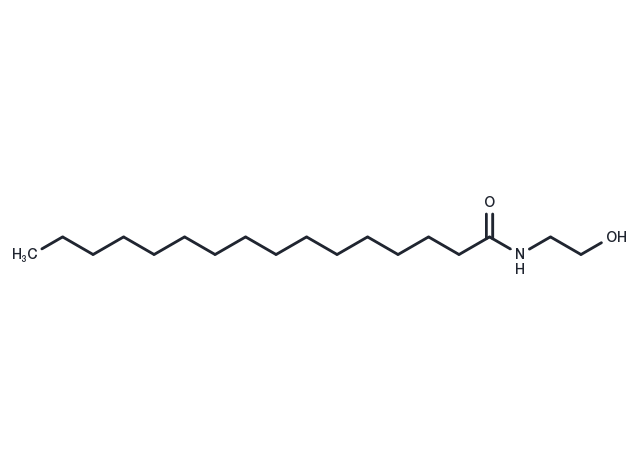store at low temperature
Powder: -20°C for 3 years | In solvent: -80°C for 1 year
Palmitoylethanolamide (Impulsin) is an endogenously fatty acid amide. It has a role as an anti-inflammatory drug, an antihypertensive agent, a neuroprotective agent and an anticonvulsant.Upon administration, palmitoylethanolamide may inhibit the release of pro-inflammatory mediators from activated mast cells.

| パッケージサイズ | 在庫状況 | 単価(税別) | |||
|---|---|---|---|---|---|
| サンプルについてお問い合わせ | |||||
| 10 mg | 在庫あり | ¥ 10,000 | |||
| 25 mg | 在庫あり | ¥ 15,000 | |||
| 50 mg | 在庫あり | ¥ 20,500 | |||
| 100 mg | 在庫あり | ¥ 37,500 | |||
| 200 mg | 在庫あり | ¥ 53,500 | |||
| 500 mg | 在庫あり | ¥ 89,500 | |||
| 1 mL * 10 mM (in DMSO) | 在庫あり | ¥ 9,000 | |||
| 説明 | Palmitoylethanolamide (Impulsin) is an endogenously fatty acid amide. It has a role as an anti-inflammatory drug, an antihypertensive agent, a neuroprotective agent and an anticonvulsant.Upon administration, palmitoylethanolamide may inhibit the release of pro-inflammatory mediators from activated mast cells. |
| ターゲット&IC50 | PPARα:3.1±0.4 μM(EC50) |
| In vitro | PEA protects cultured mouse cerebellar granule cells from glutamate toxicity and enhances microglial cell motility. In the mitochondrial fraction from cells stimulated with PEA, steroidogenic acute regulatory protein (StAR) and cytochrome P450 enzyme(P450scc) expression increases, both comprising proteins considered to be involved in crucial steps of neurosteroid formation. Moreover, PEA shows a protective effect, reducing malondialdehyde formation in cells treated with L-buthionine-(S,R)-sulfoximine, a glutathione depletor and the effect of PEA is partially inhibited by finasteride, a 5a-reductase inhibitor[2]. |
| In vivo | PEA attenuates inflammation in wild-type mice but has no effect in mice deficient in PPAR-α. PEA has been shown to inhibit peripheral inflammation and mast-cell degranulation as well as to exert neuroprotective and antinociceptive effects in rats and mice. These actions are accompanied by changes in nitric oxide production, neutrophil influx, and expression of proinflammatory proteins such as inducible nitric oxide synthase and cyclooxygenase-2[1]. In addition to its known anti-inflammatory activity, PEA regulates many pathophysiological processes, including pain perception, convulsions, and neurotoxicity. In the central nervous system (CNS), where PEA is present at detectable levels, its concentrations significantly increase under pathological conditions, such as excitotoxicity, brain ischaemia and neuroinflammation[2]. |
| 細胞研究 | C6 glioma cells (300 000?P60 dish) or astrocyte primary culture are incubated in serum-free DMEM at 37℃ for at least 24 h before each experiment. Then, cells are treated with PEA (10 μM) for 24 h in serum-free medium, in the presence and absence of GW6471 (10 μM) added 30 min before ethanolamide treatment. The concentration of PEA is chosen on the basis of preliminary experiments, assessing drug efficacy without modifi-cation of cell viability. PEA and GW6471 are first dissolved in absolute ethanol and then diluted with DMEM. The final ethanol concentration was< 0.5%. Mitochondrial protein extracts from C6 or astrocytes are obtained. Alternatively after 24 h of starvation in serum-free DMEM, C6 cells are treated with FIN (100 nM). After 30 min, PEA (10 μM) and?or ALLO (3 μM) is added and, 30 min later, are stimulated with BSO (10 mM). After 18 h, MDA is evaluated. In this set of experiments, FIN and?or PEA are dissolved in dimethylsulphoxide (DMSO) and then diluted with DMEM (0.1% final DMSO concentration).(Only for Reference) |
| 別名 | Mackpeart DR 14V, N-palmitoylethanolamine, Loramine P 256, Impulsin, AM 3112, Palmidrol |
| 分子量 | 299.49 |
| 分子式 | C18H37NO2 |
| CAS No. | 544-31-0 |
store at low temperature
Powder: -20°C for 3 years | In solvent: -80°C for 1 year
DMSO: 1mg/ml, Sonication is recommended.
Ethanol: 7.5 mg/mL (25 mM)
You can also refer to dose conversion for different animals. 詳細
bottom
Please see Inhibitor Handling Instructions for more frequently ask questions. Topics include: how to prepare stock solutions, how to store products, and cautions on cell-based assays & animal experiments, etc.
Palmitoylethanolamide 544-31-0 DNA Damage/DNA Repair Metabolism Microbiology/Virology PPAR Endogenous Metabolite Influenza Virus inhibit Loramine P-256 Mackpeart DR 14V N-palmitoylethanolamine AM-3112 Loramine P 256 Inhibitor Loramine P256 AM3112 Impulsin AM 3112 Palmidrol inhibitor
